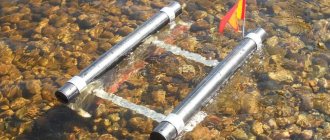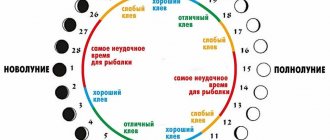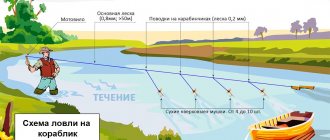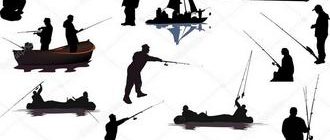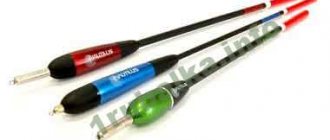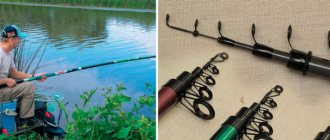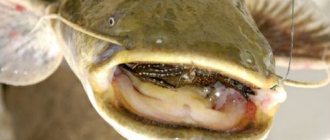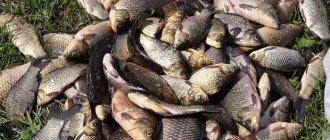There is a fishing method that can bring you a bite at any time of the year, especially in winter and early spring. This is a zig rig. In my opinion, the Zig Rig is one of the best and most effective (if done correctly) ways of catching carp. At the same time, it is one of the most underrated and misunderstood fishing methods. Some people rarely use it, while others completely ignore it.
At certain periods of time, the carp simply are not interested in our bait. There are many reasons for such periods of inactivity, such as the weather. But in the first place, it seems to me, is the carp’s preoccupation with eating natural food sources. It is during such periods that a zig rig can show its best side and earn you a bite faster than any other equipment. I’ve already lost count of how many times I’ve fished with a zig rig, even with one fishing rod, and it allowed me not to be left with nothing. In this article I will try to give my perspective on the Zig Rig based on seven years of experience using it and hopefully give you some starting points to think about.
Natural food supply and fishing location
As with traditional bottom fishing, finding the spot is very important when fishing with a zig rig. First of all, the fish that appears on the surface will indicate the right place. This is the first sign I look for. In some cases, the exits can be very obvious, with loud splashes, in other cases they are almost imperceptible exits to the surface. In my opinion, both options indicate that the fish eats natural food that moves in the water column, which means it’s worth trying a zig. I remember one winter session at Monks Pond in Cambridge. The weather was cold and cloudy, with a slight wind blowing, and I did not see a single bite during the 24 hours I was on shore. On the second morning I noticed a hint of movement near the surface, which I interpreted as an uncertain exit. I thought it was a big rudd or even a pike, but still decided to throw the rod there. I cast a zig, and by the end of fishing from this point I caught 5 carp - 3 of which weighed more than 13 kg.
What is interesting about zig rig fishing is trying to understand its theoretical foundations. Why does this work and when might it work? Sitting on the shore, have you noticed swarms of mosquitoes around? These little creatures have emerged from the very body of water where you are, and they are essentially one of the stages in the life cycle of bloodworms, one of the main natural food sources for most fish in the body of water, including carp. A little science. Hundreds, even thousands of mosquitoes that you see around you mate with each other. During this ritual, they will lay eggs while skimming the surface of the water in flight. These eggs are not laid one at a time. Thousands of eggs are connected into one whole, which gives them extra weight and allows them to sink to the bottom. At the next stage, a larva hatches from the egg, which burrows into the mud and forms a kind of tube in which it lives. At this stage they grow, acquire the famous dark red color - and behold, the bloodworm is here. After a few weeks, the bloodworm pupates and rises to the surface. Then a mosquito hatches from it.
At the stage when the pupae reach the surface, fishing with a zig rig can be simply stunningly effective. It is at this time that you can see the carp showing up at the surface. Observing the pond is the main key to success. I look for the "activity" described above first, as finding the silty areas where the pupae emerge can be challenging. But the most important thing is where the carp wants to be. I can't put it into words when it comes to zig fishing.
If there are no visible signs of carp activity, I will look for bloodworm deposits. Muddy areas in the near-shore zone or in the lower areas of the edge are a good reporting point. I don't overlook pits or small changes in depth, navels and plateaus. Bloodworms will gather at the lowest point of such terrain features. In any case, look at what is happening in front of you: white fish like roach or rudd hitting the surface of the water, flocks of seagulls congregating in one place, ducks feeding on the surface - all of this indicates the location of natural food stores. This is a food chain in which both the inhabitants of the reservoir and birds participate. Another situation: in the warm season, elevated areas of relatively shallow gravel edges (from 90 cm to 1.5 m) can be an excellent place for fishing with a zig rig, because the carp will patrol such places.
In what weather is zig rig fishing effective? I've caught carp on a zig rig in a variety of conditions. From hot sunny days to cold winter nights, in rain, strong winds, fog and even snow. However, there is one factor that I always pay attention to - atmospheric pressure. Many people assume that carp perceive changes in atmospheric pressure through the swim bladder. As a result of communicating with many anglers and reading materials on this topic, I came to the conclusion that a certain general belief is as follows: when atmospheric pressure is high, carp spend a lot of time in the middle and upper layers of water. This is especially true in deep waters as the pressure at the bottom can cause discomfort in the carp, which can be felt through the swim bladder. Please note: this is not true, I know many anglers who have caught a lot of fish from the bottom in deep areas with high atmospheric pressure. But if you look at my own results using the Zig Rig, it turns out that I caught 80% of the fish at pressures above 750 mmHg.
My ready-made zig rig leashes - for all depths!
ABC of carp fishing: zig-rig
157
We recommend viewing
One of the most difficult periods for carp fishing is during the summer heat and sweltering heat. The temperature of the water rises with incredible speed, sometimes it even seems that it is about to boil. The oxygen content in water drops rapidly. More and more fishing enthusiasts are taking vacations and going fishing, and this is greatly increasing the pressure on fish. Such circumstances in no way make our task of catching the desired trophy any easier. To achieve success in such conditions, you have to resort to various kinds of tricks. One of these lifesavers for the summer heat is the installation of a zig-rig. This is a truly powerful weapon that brings bites even when the fish flatly refuses to take the baits located on the bottom. In addition, the zig-rig rig has proven its effectiveness for short fishing trips.
Zig-rig fishing is an unusual technique that stands out significantly from classic carp fishing. Incredibly long leashes, sometimes reaching 6–8 m in size, constantly get tangled when casting and retrieving. It is necessary to maintain a rapid pace of fishing and cast the bait as accurately as possible over the bait floating in the water column. This is why many anglers cannot overcome the psychological barrier and do not believe in the success of zig-rig fishing. However, this technique often brings success when the angler does not receive any response from the fish on the bottom.
In technical terms, it is difficult to imagine a simpler installation than a zig-rig. A piece of shock leader (braided or monofilament - the angler decides) is attached to the main fishing line, onto which a safe clip is put. The clip allows you to easily release the load if it gets caught on snags, seaweed or stones. For zig-rig fishing, there is no need to complicate the installation with leadcore or anti-twist tubes. A regular swivel is attached to the shock leader, preferably with a quick release, which will allow you to quickly replace zig-rigs for experiments with different depths. Often in carp literature they write about the need for a hinge when moving from an Inline clip or sinker to a leader. Such a hinge, achieved thanks to an additional ring on the swivel or the use of a fastener, is justified for sinking rigs, where the length of the leash, as a rule, does not exceed 30 cm. However, for effective fishing with a zig-rig, we need the most rigid mounting, which will allow, as far as possible It is possible to separate the long leash and the main line during casting, which significantly reduces the likelihood of the entire rig getting tangled in flight. After we put the zig-rig leash on the quick release swivel, we must slide the impact cone onto the quick release. The longer the bumper cone, the better. Cones with increased length can be found in the Fox product range. The cone allows for a more rigid transition from the sinker to the leader and thereby significantly reduces the number of tangled leads.
When it comes to zig-rig leashes, there are a variety of options. If you are not confident in your abilities, you can purchase ready-made zig rigs. Buying ready-made leashes is also a justifiable step for very busy fishermen who do not have enough time to make leashes at home and do not want to waste precious fishing time on tying rigs. Ready-made equipment, available in various standard lengths, allows you to replace leashes in a matter of seconds and quickly adapt to constantly changing fishing conditions.
However, ready-made leaders have a significant drawback: they are made for the most frequently encountered depths, while we may need shorter or longer leaders. Therefore, it is best to make zig-rigs yourself.
The time has come to talk about the elements that we will need to make a zig-rig. Let's start with the hooks. Despite the fact that there are many different models of carp hooks on the modern carp market, there are mainly several types that are suitable for zig-rigs.
Firstly, these are half banana hooks. They have a curved fore-end of medium length and a fairly wide mouth. These are Mugga type hooks from Gardner or Arma Point SSC from Fox. The curved forend creates an aggressive angle of attack, so these models are better at detecting fish.
The second type, which is best suited for zig-rigging, is wide gape hooks. Since predominantly small hooks are used to lift small baits, the width of the mouth plays an important role: the hook must be securely fixed in the lip of the fish. The wider the gap, the more bites we can get and the more reliable the hook will be, which reduces the likelihood of an annoying slip when fishing. Hayabusa K1, Fox SSSP or Nash Fang Gaper are just a few models that have a wide gape.
Finally, the third type is hooks with an outwardly curved eye. They are specially designed for leashes made of hard materials: the outwardly curved eye allows you to maintain an optimal angle of attack. We are talking about models such as Korda Choddy or Fox SR.
As mentioned earlier, to make a zig-rig, small hooks are used - No. 8 or No. 10. The reason is simple: the larger the hook, the heavier it is. It will be more difficult for a small bait (foam, ball or floating boilie) to pull a heavy hook upward, especially when fishing at great depths with long leashes.
We are not limited in the choice of leader material for a zig-rig. However, it is worth considering the fact that some materials have the very unpleasant property of curling in flight after two or three casts. Therefore, you need to pay attention to materials such as Zig Link from Gardner or Zig+ Floater from Fox. These materials, in addition to the fact that they do not begin to tangle after several casts, have a number of important advantages. These materials are made of monofilament that is almost invisible in the water, which is less alarming to the fish. In addition, they were specially designed for zig-rig fishing, so they have good buoyancy. This is a very important property because the buoyancy of the material greatly improves the presentation of the bait. Possessing positive buoyancy, the leash does not drown the bait, but, on the contrary, allows it to be positioned correctly in different water horizons. An important factor is the ability of the previously mentioned materials to maintain their characteristics over a long service life. When we make a six-meter zig-rig, and the next time we cast we have to make a new leader, because the previously made installation got tangled and is no longer suitable for fishing, emotions begin to take over, we get irritated and fishing no longer brings us the desired pleasure.
Separately, it is worth noting how the nozzle is attached to the leader and what knot is used to attach the hook to the leader material. If we want to place the attachment on regular hair, then we need to tie a regular knotless knot, right? However, a knotless knot tied to nylon begins to rotate during fishing, which can lead to misalignments or breaks due to rubbing of the material. Therefore, it is best to tie the hook with knots that are designed for hooks with blades. Such nodes are incredibly strong and are not prone to parasitic rotations. It is not difficult to notice that after fishing, the knotless knot is always displaced, while other knots maintain their position.
There is another way to present the nozzle, which most often is a piece of foam. Some are of different colors and have special fasteners for foam. All we have to do is select the “lazy one” of the desired color, tie the hook to the leader material (with “Palomar” or “Grinner” knots), slide the “lazy one” onto the hook and fix a piece of foam of the required color in the “lazy one” loop, then cut off the remaining part of the foam. A fast and very convenient solution! In addition, multi-colored “lazy ones” allow you to create various color combinations that provoke the carp to bite!
It's time to move on to the nozzle. All kinds of floating materials are suitable as bait - cork balls, multi-colored foam balls, pieces of foam and floating boilies. The most convenient and universal attachment is a regular foam. The piece of foam should not be too large - the size of the foam should be sufficient to raise the hook to the desired depth. The classic zig-rig is the combination of yellow and black, however, other colors can bring no less success - the main thing is not to be afraid to experiment and look for the color scheme that the carp like most on a given reservoir at the moment. When choosing foam, it is important to take into account its density, buoyancy and brightness, and, moreover, recently fluorescent foams of brighter, even aggressive colors have begun to appear on the market, which visually irritate carp and provoke them to attack.
There is a lot of discussion surrounding the question of whether it is worth soaking foam in various dips or flavorings. Some anglers claim that the carp reacts exclusively to a visual signal, to the foam itself, which it associates with a small larva or bug. However, if we deepen the foam or dip it before casting in special liquids such as Fog Blaster from Fun Fishing or GOO from Korda, which create a bright colored cloud next to the bait and have a pleasant smell, then it is unlikely that a school of carp will decide to swim to the other end of the pond. Rather, on the contrary, the fish will be interested in the fragrant trail emanating from the nozzle and will be more likely to try to take it into the mouth. Strong attractive signals are also created by various oils (hemp, salmon, trout and halibut), which spread well in warm summer water, attracting carp from distant shores.
Another extremely important component of successful zig-rig fishing is bait. On any forum you can find hundreds of recipes for so-called “soups” - extremely liquid bulk bait that forms a persistent cloud of turbidity in the water column. Of course, in certain conditions they are a deadly means of luring, but it is not always necessary to mindlessly pour soup over our baits.
Often you have to create a kind of background on the bottom using particles of different sizes. Good old balls of loose bait, which contain heterogeneous particles, are perfect for this. You can throw such balls using both SPOMB and eggplants. An essential component of the mixture for balls are oils, which spread very quickly throughout all water horizons.
After about 20 solid balls are sent to the selected area, we need to slightly re-moisten the bait mixture so that upon contact with water, the balls thrown with the eggplant or the cakes inside the SPOMB will crumble and gradually fall to the bottom on top of our baits in pieces of varying weight and size.
This style of feeding is suitable for areas where the fishing depth exceeds 7–8 m. The described tactics are also justified at medium depths with strong winds or in reservoirs with a weak undercurrent. Indeed, if our baits are at depths of 2.5–6 m with a depth in the fishing zone of 8 m, then it is almost certain that liquid baits such as soup will not sink over the baits, but will go far to the side. That is why we need the mixture to quickly reach the bottom and from there begin to release various attractive particles and oils into all water layers.
When feeding, it is important to adhere to the rule “better less, but more often.” When fishing at deep depths, first, using 15–20 dense balls, a background is created on the bottom, after which 5–10 waterlogged balls or cakes are thrown into the area. Then, at intervals of 15–30 minutes, several rockets with soup or several waterlogged balls are sent to the site. You can notice that the feeding intensity is quite high, which is why very often the bite occurs at the moment when you are holding the spod rod in your hands. Maintaining constant activity in the area through regular feeding is one of the main factors for successful zig-rig fishing.
The first attempts to bring out fish on a long zig-rig leader are not so easy, especially if you are fishing alone. That is why fishing on a zig-rig together is a huge advantage, a real trump card! It not only simplifies the fishing process, but also allows you to continuously maintain the required feeding activity at the fishing point while retrieving the pecked fish. If you are fishing alone, then stick a regular stand into the water, which will support the handle of the landing net, and the float for the landing net will allow you to give it a slight angle, slightly opening the entrance into the triangle. All that remains is to bring the fish into the open landing net. As soon as the fish is inside the coveted triangle, we need to slam the net over it as quickly as possible.
As for the casting technique, there is nothing special here. It is important to always cast using the clip. The clip on the reel spool not only allows you to regularly achieve perfect accuracy, but also slows down the sinker in flight, which is followed by a long leash by inertia. Thus, before entering the water, the leash straightens and moves as far away from the main line as possible. Before casting, you should make sure that the leash is on a flat and clean area, for example, on a carp mat or a special tarpaulin. This will allow you to make confident casts without fear of breaking the leash that gets tangled in bushes or grass. To prevent the hook from clinging to everything around when casting, you can ask your partner to hold the leash by the nozzle while casting, wrap the hook in PVA foam, or place it on a regular magnet. If you are fishing in windy weather, wet the mat or tarp. A wet mat will better hold a long leader, allowing you to make confident casts.
It is worth noting that the zig-rig is not a means of fishing exclusively at short and medium distances. With certain skill, zig-rig fishing can be carried out at distances of 110 m. The main thing is not to sacrifice accuracy for the sake of range. And of course, you must be well physically prepared to withstand tempo feeding at distances of 120–130 m...
Source: rsn.ru
Interesting article to read:
- ABC of carp fishing: Chod-rig
- Carp fishing lesson: second
- Carp fishing lesson: first
Zig rig mechanics
When fishing with a zig rig, you need to ensure the presentation of the bait in the middle or upper layers of the water. There are many ways to do this.
An adjustable zig is a great way, many manufacturers already sell adjustable zig rigs and they are good. But I like to keep things simple. From my own experience: the fewer additional components on the line, the more confident the contact with the fish, the better. I aim for the bait to be as close to natural invertebrates as possible. Therefore, I prefer baits like small pieces of floating foam and small pop-ups from 10 to 12 mm. Consequently, I use small hook sizes: Drennan Super Specialist #8 is my choice in this situation. They are very strong and sharp, have a short sting, which, in my opinion, eliminates the possibility of the hook moving in the fish’s mouth and prevents damage to the hook. I always attach the bait using a regular knotless knot. I tried attaching baits directly to the hook, but as a result I lost a lot of fish and came to the conclusion that the hooks in this case are much worse than when using a regular hair rig. For leader material I use Drennan Double Strength; It's inexpensive, tangle-free, and very durable for its diameter.
Given the small size of the hook, I don't really want the sinker or anything else hanging around on the rig, especially when using long leaders. I experimented with different ways of fishing with a zig rig and came to the conclusion that if the sinker is dropped, the chances of successfully landing a fish increase. Therefore, a safety clip, in my opinion, is the best element to use in a zig rig installation. At the same time, I need to be 100% sure that the sinker will shoot off when bitten. I cannot express in words the difference in fishing in a situation when the sinker remains on the clip and when it is dropped. As a result, this greatly influences the successful introduction of fish into the landing net. Especially in the case of using leashes up to 2 m long. In addition, in the event of a break or cut, the carp should not swim with a long leash and a heavy sinker at a distance of more than a meter behind it.
My installation with a safety clip has evolved over time. I started with a regular clip with a rubber shank that didn't fit all the way onto the clip. But I discovered that there was no guaranteed shot of the sinker, and over the course of four months in the spring of 2009 I lost a large number of fish, including large ones... something had to change! As a result, I completely abandoned the rubber shank and replaced it with a small piece of silicone tube. This improved things, but it was still not an ideal solution. In some cases, the sinker was not shot. In addition, I had the problem of the sinker dropping while casting.
In 2010, I stopped by the MCF factory to see Dennis. They showed me a new clip - MCF Dumper Lead Clip. Its design is simple and at the same time unique. The sinker is released immediately after the bite, which is important on overgrown or snag-ridden reservoirs. It is important that you do not lose the sinker during casting or when reeling the rig through the weeds. From a zig rig fishing point of view, this is ideal. The beauty of this clip is that it goes through the guides of the rod. This is relevant when fishing with long leashes over 3.5 m.
As for the sinkers. I prefer pear-shaped or long-casting weights that weigh at least 85 grams. This allows me to cast to the desired point and, most importantly, provides a reliable hook when biting. This is very important when fishing with long leashes.
Varieties of Zig Rigs
A zig rig is a simple installation with which you can feed a floating bait at any depth. The classic Zig Rig installation looks like this:
This is a zig rig with an adjustable nozzle depth. As you can see, the main elements of installation are a sliding sinker, which is limited by a stopper. Next comes an anti-twist in the form of a tube. Then there is a float to which a leash with a floating attachment is attached. The leash can be made of fluorocarbon. The essence of this installation is to place the nozzle in the desired horizon. The float moves along the leash, thus changing its length. The leash is attached to the connector. This type of installation is useful in cases where it is not clear at what depth the carp is standing at a given time.
There are zig rigs with a fixed or semi-fixed version. In this case, the weight is unfastened using a clip, and the leash is attached to the connector. The length of the leash remains unchanged. But if necessary, the leash can be easily changed. A fixed zig rig looks like this:
What hooks are best suited for our installation? One of the most proven models are half bananas.
As you can see, such hooks have a curved shank and a fairly large barb. With their help, you can detect carp well even with short hooks.
Another type of hook, which is often used when fishing with zig rig rigs, has a wide mouth.
Since small hooks are required to lift small baits, models with a wide mouth will allow you to effectively hook fish.
Another type of hook that works well for zig rig rigs are models with an outward curved eye. Such hooks are used in conjunction with rigid leashes. They provide the optimal angle of attack.
Mostly hooks Nos. 8-10 are used. Small hooks are used for attaching small pop-ups, foam balls and boilies. When fishing with larger hooks, large balls are used. In general, we need to ensure that the ball lifts the hook into the water column. Since carp hooks are usually made of thick wire, we will reduce the weight of the hook due to its size. Thus, the ball will raise the hook a distance equal to the length of the leash.
Lead material should be selected more carefully. There are materials on sale that are designed specifically for installation of zig rigs. Their peculiarity is that when casting and reeling in, they do not get tangled or twisted, and remain smooth and beautiful after many fishing trips. The leader material is made of transparent monofilament line, a line that is almost invisible in the water. The fishing line is of a floating type, which is very important when using it on a zig rig installation.
As for sinkers, it is better to use models weighing 3-4 ounces. With their help, you can make long casts, and the equipment will be clearly fixed in one place.
On such leashes the bait looks more attractive to carp. It has been noticed that the number of bites on such installations is significantly higher.
Depth when fishing with a zig rig
Everything depends on the results of observations. If you see the signs of fish activity that I described above, then you are halfway to success. But if you are fishing blind, then I would follow one general rule. In the warm season, I start fishing with a zig rig 60 cm from the surface. In cold weather, I always start by fishing in the water column. That is, if fishing in an area with a depth of 3 m, I would set the zig to 1.5 m. The great thing about fishing with a zig rig is that you can always actively experiment with depth and fishing areas until you get a bite. For example, in the same fishing conditions at a depth of 3m, I would put each rod at different depths: for example, 1.2, 1.8, 2.4m (or other variations) until I found the depth where the fish were holding. If you have a friend fishing next door, you can work as a team, exploring different depths until you determine the length of leader you need for your zig rig.
To be able to quickly change the fishing depth, I make leashes in advance. I don’t want to waste time making new equipment when the task is to change the fishing depth for a zig rig. Each leash ends in a loop that attaches seamlessly to the clip...simplicity at its best!
Special leash holders for zig rig allow you to store and collect leashes quickly and safely. This is better than leaving them hanging on a tree (which is also dangerous for birds). How many times have I seen abandoned zig rig leaders like this... not the best fishing style.
Zig rig device
Zig rig has the following device:
- There is a sinker on the line. It allows you to immerse the tackle to the desired depth.
- An anti-twist tube comes from it. A special float for a zig rig is attached to its second end.
- A leash with a hook and a floating bait is attached to it.
This design allows you to catch carp at a certain depth.
Zig rig equipment
During underwater fishing, it is positioned as follows:
And also to understand what the essence of carp fishing with a zig-rig is, underwater photography from the bottom of the reservoir:
Choosing foam for zig rig
Choice of nozzle. In my opinion, this is the most exciting part about zig rig fishing. Why on earth would a carp eat a small piece of foam or pop-up suspended in water? But they do it. The biggest obstacle you need to overcome is accepting this fact in your own mind. I remember one spring day on Monks Reservoir we were discussing zig rig fishing with a man and he just couldn't understand why he had to work. That morning I caught a carp named “Her Majesty” weighing 15 kg, this fish had not been caught for 2 years. He made me laugh a lot when I told him about it.
Floating foam for zig rig
Without a doubt, small pieces of foam have proven to be the most successful bait in my experience. I tried everything, but the foam always remained the leader. I think this is due to both its buoyancy and the variability of its use - you can give it the shape that you need. I don't flavor my foams, but that's a subjective choice. I know many who flavor them and achieve excellent results. Here's another thing to think about.
Black, in my experience, has proven to be the most successful color. Although I caught well with yellow and even white. Interestingly, I have caught a lot of fish on white foam during the full moon, especially in cold water. I achieved good results using black foam mixed with white foam. I was inspired to try this combination by a conversation with Dennis McFetrich, during which he showed me his fly fishing flies. The flies had a black base and a small speck of white material at the bend of the hook. It was an imitation of a pupated bloodworm, the white component representing the air pocket they use to move through layers of water.
Pop-ups with a diameter of 12 mm have always performed well. Especially when you add “soup” on top. It is important to note that the carp will take, or, more precisely, examine everything that is suspended in the water column. Carp is a very inquisitive creature. I think any attachment will work, especially during the warmer months. However, when the fish are engaged in eating natural food, you can fish the zig effectively and consistently. In this situation, the foam catches any other types of baits.
As I said, winter and early spring are great times for zig rig fishing. There were times when I arrived at a pond without a single boilie, even without a jar of pop-ups. This requires some confidence, and believe me, it's worth it. Remember the capture of "Big Scaly" at Monks Reservoir. This fish only comes around once or twice a year and Dave Lane caught it on a zig in February in some very difficult conditions. A week later the lake was covered with a thick layer of ice, if I'm not mistaken. In my opinion, this is an excellent example of true fishing art.
Attraction
Creating a “food situation” or area that carp might be interested in in waters with high fish densities can be devastatingly effective. Over the years I have tried many "soup" mixes, including ingredients such as milk powder, evaporated or regular coconut milk, ground hemp, ground sweet corn - these are the few ingredients I can list. I always mix them with pond water and cast them with a spod on top of my baits to create an attractive cloud of turbidity.
“Her Majesty” in all her glory
Bite indication
This is a very interesting topic when it comes to Zig Rig fishing. Opinions on this matter vary. I've seen Zig Rig fished with tight lines, and I've seen those who prefer to fish with slack lines. The last approach is not for me. 90% of bites on zig rig in my practice were active “locomotives”. But sometimes there were bites on the shore. I think the main factor that matters in this case is the correct installation of the safety clip. When the fish is hooked, the sinker is dropped and the fish is left with free line.
After a bite, the fish can move in any direction - left, right, and even towards you. In my opinion, fishing with slack lines is pointless because you will not be able to understand what exactly is happening. For zig rig fishing, it is better to use bats, because... they are more sensitive and transmit any movement at the other end of the fishing line. I use Rattler bats.
I remember one fishing trip on Monks Reservoir in 2011. I fished in one of the deep areas. On the first morning there were a lot of carp showing up at the surface, they were clearly feeding on the natural food that was rising through the water. The depth in this area was about 4.3 m. And although the fish appeared directly at the surface, I assumed that they feed mainly in the lower and middle layers of water. I chose a 1.8 m long leash with a traditional piece of black foam for me. I cast the zig rig and after 15 minutes I received a very uncertain and weak signal about a bite on the shore. After an epic battle, a mirror carp weighing about 16 kg ended up in the landing net. If the presentation and the gear used for the indication had been inappropriate, I would never have known that this fish took the bait.
Casting zig rig
This is the question that gets asked again and again. How to cast a Zig Rig without it getting tangled? First of all, the main thing is to keep the equipment very simple.
In addition, before the cast sinker hits the water, you need to slow down the line a little so that the leader and bait come forward and straighten out. If this is not done, the equipment may become tangled. This is especially important when fishing with long leashes. Before casting, I do not place the entire long leader in one place on the ground. I place the bait on the ground (away from the shoreline and where I'm casting) and then walk forward so the leader is straight. This helps prevent tangling and allows you to cast further.
In some places, placing the nozzle on the ground for casting can be problematic: grass, twigs, etc. will interfere with casting. In such cases, I use a small container of water. I put the bait in the water on the surface and cast it. This method is 99% effective in avoiding snags on bushes, reeds, branches and even your tent.
Carp about 16 kg - thanks to the zig rig
Fish safety
I always pay attention to this point, and especially when fishing with a zig rig. Zig rig fishing has grown in popularity and this has unfortunately led to it being banned from many waters due to its misuse. The main reason for this was frequent breakages due to the low breaking load of the leaders that many anglers used. As I said, I usually use Drennan Double Strength. The minimum breaking load is 15 lb, which is sufficient for many situations. Fishing on a zig rig can be quite epic, and the bite itself is very sharp. Therefore, you need to use a leash that will cope with its tasks. I have seen anglers often use 8, 10 or 12 lb breaking load leaders. In my opinion, this is crazy, especially on ponds overgrown with algae. The rationale for this is that the fish will see a thicker line in the water. But I disagree with this for two reasons. First, most of the fish I caught on the zig rig were hooked on the lower lip. This suggests that they are taking the bait from above, going down to it: so how will they see the leash? Second: when the fish are actively feeding on various larvae, they are least concerned about the presence of a leash in the water.
Two years ago I observed a situation where the fish were so keen on eating natural food that when I threw a marker to measure the depths, they continued to be active near it.
All of the above applies to the main line. In some situations it is necessary to cast the zig further than 100 meters. But there is no need to switch to fishing lines with a low breaking load. If you have a break, then not only your long leash will remain in the lake, but also a piece of the main fishing line. I tend to stay away from fluorocarbon when fishing zig rigs and prefer traditional quality monofilament.
Fishing for carp using the Zig Rig rig.
Author: John Hinkley .
You may ask yourself why fish with this rig when you see that most other anglers are catching carp from the bottom, while the carp spend most of their time off the bottom. In such cases, the Zig Rig will help you catch carp.
Will the carp that is swimming on top take the bait that is on the bottom?
Depth
Once you have decided to use a Zig Rig for fishing, the next question is, what depth should we set? As a rule, I start setting the depth so that the bait is somewhere in the middle of the depth of the body of water in which I am fishing. For example, if the pond is 10 feet deep, I start fishing at 5 feet. Other times, when I'm going to fish with two rods, I take a different approach. I cast fishing rods at different depths until I catch a fish on one of them. For example, in a 10 foot deep pond, I will set the depth on one rod to 4 feet and the other to 6 feet. If I catch a fish on a 6 foot rod, then I will set the depth on the second rod to over six.
Fishing with a Zig Rig is fast. If you don't get a bite for a few hours, you might want to change the depth.
If there is no bite, you should change the depth
Preparations.
The next thing to pay attention to is how you set up your rig. Typically, I use a size 10 hook, ESP Big T, hook set, made from 10lb or 12lb Drennan mono. How it will behave in water depends on this. I attach a leader to the end of the line, which allows me to remove the sinker first from the water. This makes catching fish much easier.
My way of setting up the Zig Rig
Bait
There are a number of lures that can be used when fishing with a Zig Rig. From floats to cork balls. I prefer to use 15mm brightly colored, floating boilies. I almost always cut off the top layer of the pop-up, thereby removing the provocative shade and giving it a more natural shape. It is also necessary to adjust the length of the hair. I have had the best results with the boilie as close to the hook as possible.
Ideal bait for Zig Rig
Next time try the Zig Rig. You may discover that this tool works best when nothing else works for you.
The result of fishing with the Zig Rig may not be a large carp, but it’s better than nothing.
Source: www.carp-uk.net, translation by Sergey Shekolyan, for the website carpfishing.by


